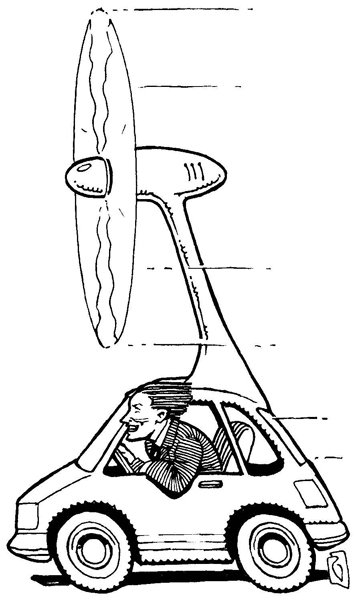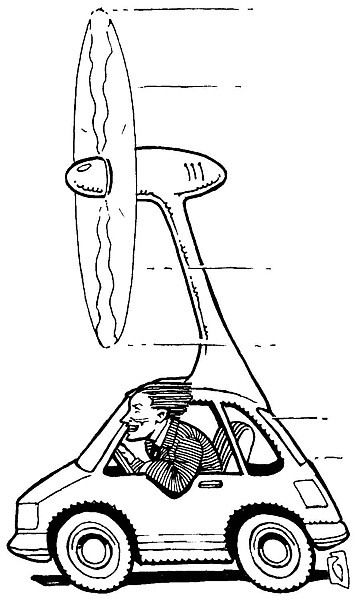 Facebook
Facebook
 X
X
 Instagram
Instagram
 TikTok
TikTok
 Youtube
Youtube

Hi Matt:
Recently I was gobsmacked by two ideas so obvious that they must be wrong...I mean, since nobody’s using them. First, I thought of wind turbines in electric cars. Propelling the car would run air through the turbine to charge the battery. My guess is that the problem is that the turbine would catch the wind and create resistance that would impede the vehicle. The other obvious idea that must be wrong is this: people sometimes pedal bicycles to power generators to run small appliances. Why is it that the wheels on electric cars can’t be used to feed power to charge the battery?
— Margaret

You’re right about the first problem in that it’s a zero-sum game. In order for one party to win, the other must lose. You could only generate as much power with a wind turbine as you spent pushing the car through the air to turn that turbine. You’d be robbing Peter to pay Paul, as the expression goes. Wind turbines are also fairly inefficient and convert only 40–60 percent of their kinetic energy into electricity, so you would be looking at an impressive net loss of energy. I found an interesting study from last year’s Renewable Energy Congress in Sweden where the authors proposed putting turbines inside the car to allow airflow through the vehicle. The hypothesis was that cancelling the effects of “form drag” (caused by air pressure inequality in front of and behind a moving object) would negate the effect of friction drag caused by the turbines grabbing air to generate power. Nice idea, but it only sort of worked out in testing and it needs a lot more exploration if it’s ever to become practical.
The wheels on electric cars are used to power the batteries, albeit in a slightly different way than what you’re thinking. The bicycle-powered generator takes force that you’re applying to the pedals and translates that into electrical energy. If you did the same thing with an electric car, you’d be taking the energy that the engine puts out, capturing it, and sending it back to the batteries; much like the problem of a turbine on top of a car. That would be a fun engineering problem but a bad way to power a Prius. I saw it written that “the secret sauce of an electric car is not in how it accelerates, but how it brakes.” What electric cars do is capture the force that the road exerts on the wheels during braking. The electrical motor basically turns into an alternator that generates electricity while it slows the car down, which is a genius idea and the thing that made hybrid cars possible in the first place.
Heymatt:
How bright is too bright for headlights? Sometimes, I feel blinded by the brightness of some people’s headlights on their vehicles, especially if it’s a tall truck sitting right behind me or a motorcycle with a huge light or two. I know they want to be seen — why not a big flashing neon sign that says, “Watch Out, Here I Am”? There must be some law against blinding others on the road in the name of safety. Can I turn those people in? Maybe I am one of them and don’t even know it?!
— Blinded, via email
Automotive regulations come from a whole host of sources that create quite the tangle of red tape. There are federal regulations as well as standards determined by the Society of Automotive Engineers (that’s the S.A.E. listed in motor oil viscosity grades like 10W-30), but it’s ultimately state regulations that impact you and me and everybody else on the day-to-day. California Vehicle Code chapter 12 has plenty of legalese on what constitutes acceptable headlights. Pretty dull stuff, but the codes unanimously agree that it’s not okay to shine directly into the eyes of oncoming drivers. They also limit the height at which lights can be mounted, done in order to prevent big trucks from searing your retinas by virtue of altitude. If people are “beaming” you, then it’s nothing more than a lack of courtesy that’s causing your blindness. I know a lot of motorcycle riders follow the conventional “wisdom” of leaving the high beams on at all times to increase their visibility on the roads.
The California Highway Patrol does pull people over for driving around with the high beams on or for having headlights that are blinding other drivers. Confusingly, new halogen technology produces massive candlepower, but any headlamps installed by automobile manufacturers are in keeping with all the regulations and industry standards I mentioned before, so they’re technically legal and not going to merit a citation. Aftermarket headlamps can be super bright, misaligned, or illegal colors (only white and yellow light is allowed to shine from the front of a vehicle), which can blind you for the sake of someone’s vanity or bling factor. In those instances, you could alert the CHP and they’d have an officer stop the offender and investigate the lights, provided someone was nearby. Don’t call 911, though. Use the CHP non-emergency number (800-835-5247), because, while annoying, shiny headlights aren’t an emergency in the conventional sense.


Hi Matt:
Recently I was gobsmacked by two ideas so obvious that they must be wrong...I mean, since nobody’s using them. First, I thought of wind turbines in electric cars. Propelling the car would run air through the turbine to charge the battery. My guess is that the problem is that the turbine would catch the wind and create resistance that would impede the vehicle. The other obvious idea that must be wrong is this: people sometimes pedal bicycles to power generators to run small appliances. Why is it that the wheels on electric cars can’t be used to feed power to charge the battery?
— Margaret

You’re right about the first problem in that it’s a zero-sum game. In order for one party to win, the other must lose. You could only generate as much power with a wind turbine as you spent pushing the car through the air to turn that turbine. You’d be robbing Peter to pay Paul, as the expression goes. Wind turbines are also fairly inefficient and convert only 40–60 percent of their kinetic energy into electricity, so you would be looking at an impressive net loss of energy. I found an interesting study from last year’s Renewable Energy Congress in Sweden where the authors proposed putting turbines inside the car to allow airflow through the vehicle. The hypothesis was that cancelling the effects of “form drag” (caused by air pressure inequality in front of and behind a moving object) would negate the effect of friction drag caused by the turbines grabbing air to generate power. Nice idea, but it only sort of worked out in testing and it needs a lot more exploration if it’s ever to become practical.
The wheels on electric cars are used to power the batteries, albeit in a slightly different way than what you’re thinking. The bicycle-powered generator takes force that you’re applying to the pedals and translates that into electrical energy. If you did the same thing with an electric car, you’d be taking the energy that the engine puts out, capturing it, and sending it back to the batteries; much like the problem of a turbine on top of a car. That would be a fun engineering problem but a bad way to power a Prius. I saw it written that “the secret sauce of an electric car is not in how it accelerates, but how it brakes.” What electric cars do is capture the force that the road exerts on the wheels during braking. The electrical motor basically turns into an alternator that generates electricity while it slows the car down, which is a genius idea and the thing that made hybrid cars possible in the first place.
Heymatt:
How bright is too bright for headlights? Sometimes, I feel blinded by the brightness of some people’s headlights on their vehicles, especially if it’s a tall truck sitting right behind me or a motorcycle with a huge light or two. I know they want to be seen — why not a big flashing neon sign that says, “Watch Out, Here I Am”? There must be some law against blinding others on the road in the name of safety. Can I turn those people in? Maybe I am one of them and don’t even know it?!
— Blinded, via email
Automotive regulations come from a whole host of sources that create quite the tangle of red tape. There are federal regulations as well as standards determined by the Society of Automotive Engineers (that’s the S.A.E. listed in motor oil viscosity grades like 10W-30), but it’s ultimately state regulations that impact you and me and everybody else on the day-to-day. California Vehicle Code chapter 12 has plenty of legalese on what constitutes acceptable headlights. Pretty dull stuff, but the codes unanimously agree that it’s not okay to shine directly into the eyes of oncoming drivers. They also limit the height at which lights can be mounted, done in order to prevent big trucks from searing your retinas by virtue of altitude. If people are “beaming” you, then it’s nothing more than a lack of courtesy that’s causing your blindness. I know a lot of motorcycle riders follow the conventional “wisdom” of leaving the high beams on at all times to increase their visibility on the roads.
The California Highway Patrol does pull people over for driving around with the high beams on or for having headlights that are blinding other drivers. Confusingly, new halogen technology produces massive candlepower, but any headlamps installed by automobile manufacturers are in keeping with all the regulations and industry standards I mentioned before, so they’re technically legal and not going to merit a citation. Aftermarket headlamps can be super bright, misaligned, or illegal colors (only white and yellow light is allowed to shine from the front of a vehicle), which can blind you for the sake of someone’s vanity or bling factor. In those instances, you could alert the CHP and they’d have an officer stop the offender and investigate the lights, provided someone was nearby. Don’t call 911, though. Use the CHP non-emergency number (800-835-5247), because, while annoying, shiny headlights aren’t an emergency in the conventional sense.
Comments